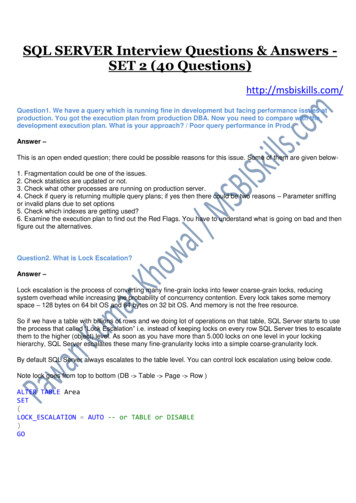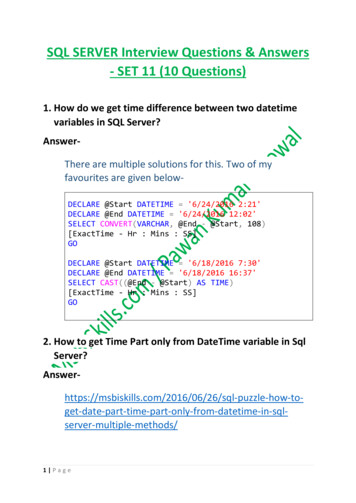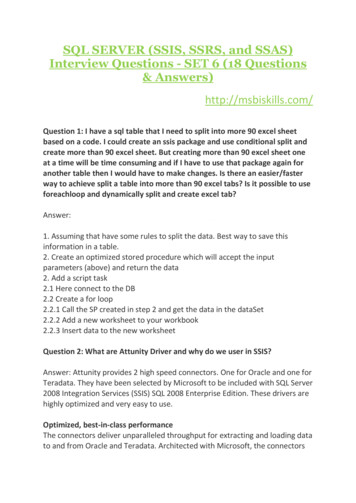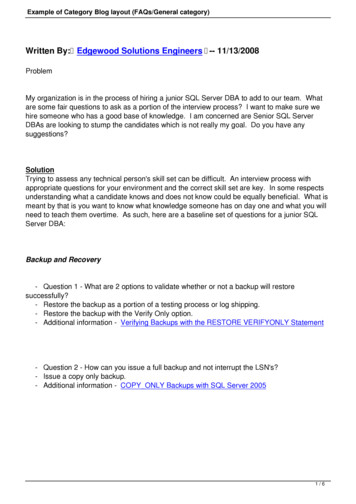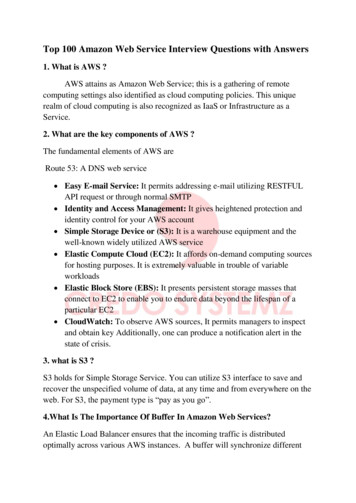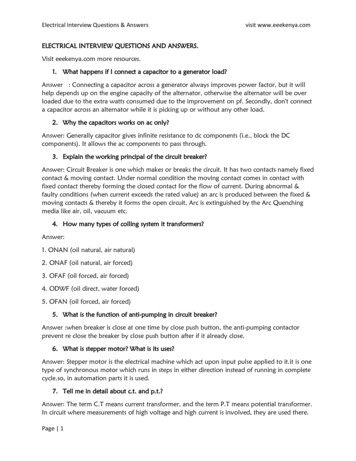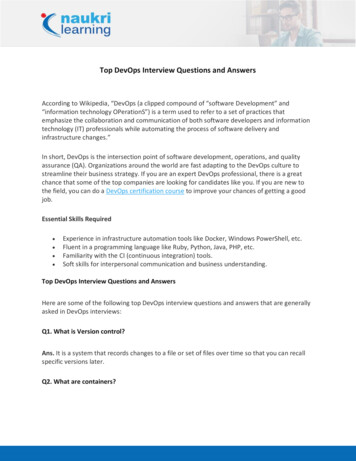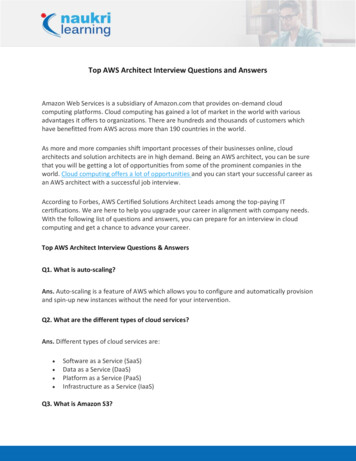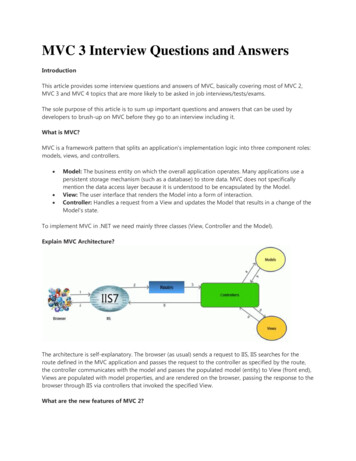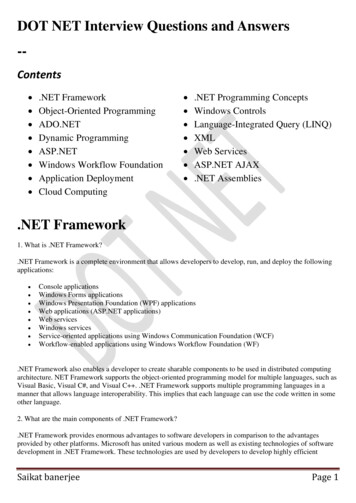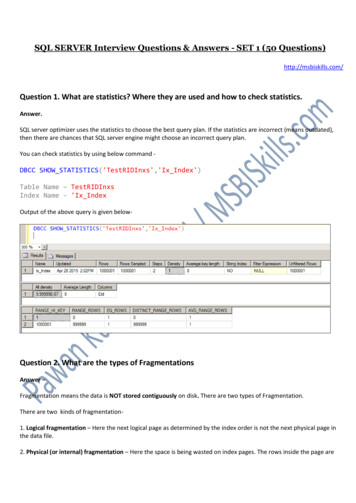
Transcription
SQL SERVER Interview Questions & Answers - SET 1 (50 Questions)http://msbiskills.com/Question 1. What are statistics? Where they are used and how to check statistics.Answer.SQL server optimizer uses the statistics to choose the best query plan. If the statistics are incorrect (means outdated),then there are chances that SQL server engine might choose an incorrect query plan.You can check statistics by using below command -DBCC SHOW STATISTICS('TestRIDInxs','Ix Index')Table Name – TestRIDInxsIndex Name - 'Ix IndexOutput of the above query is given below-Question 2. What are the types of FragmentationsAnswer –Fragmentation means the data is NOT stored contiguously on disk. There are two types of Fragmentation.There are two kinds of fragmentation1. Logical fragmentation – Here the next logical page as determined by the index order is not the next physical page inthe data file.2. Physical (or internal) fragmentation – Here the space is being wasted on index pages. The rows inside the page are
not contiguous.These can both affect query performance, as well as the expense of having to do the page split in the first place.If you want to understand this in detail please visit - entation/Question 3. Can we use GUID as Primary key in a table?Answer – We can use GUID as primary key in a table But we should NOT. It will create fragmentation issue.For details please visit - entation-in-clustered-indexes/Question 4. What is the difference between Unique Index and Unique Constraint?Answer –A unique index is just an index, whereas a unique constraint is a unique index that's listed as a constraint object in thedatabase. In the sysobjects table, the unique constraint will have an xtype value of "UQ.".Unique key basically creates a unique index internally to maintain uniqueness.Note - Unique index and a unique constraint have same effect on a table. Performance is also same for both. Commandto create unique index and unique constraint are given below.--Command to add IndexCREATE UNIQUE INDEX Ix Indexer ON TestRIDInxs(EId)--Command to add constraintALTER TABLE TestRIDInxsADD CONSTRAINT UNQ Constraint UNIQUE (EId)Now if you check the table definition (shortcut - ALT F1) it will give you below information-Question 5. What are RED Flags in SQL Server and what is there usage?Answer –
There are some flags in execution plan which normally reduces the performance of the query. Some of them are givenbelow.1.2.3.4.5.6.7.8.9.High Percentage OperationsTable Scans, Index Scans, Clustered Index ScansSpoolsParallelism operationsWarningsThick ArrowsHash JoinsBookmark LookupsSortingFor details please visit below- ce Tuning/sevenshowplanredflags/1425/- owQuestion 6. What are the types of physical joins in SQL Server? What are the different joinoperators in SQL Server?Answer –There are three types of physical joins given belowNested Loop Merge Join Hash Match Used usually when one table is significantly smallThe larger table has an index which allows seeking it using the join keyBoth inputs are sorted on the join keyAn equality operator is usedExcellent for very large tablesIf the SQL Server can’t use any of the above mentioned joins then it will use Hash Match join.Uses a hash table and a dynamic hash match function to match rowsFor details please visit below linksNested Loop Joins: /671712.aspxMerge Joins: /merge-join.aspxHash Joins: /687630.aspxQuestion 7. What is a Latch in SQL Server?AnswerLatches perform the task of thread synchronization. For example, if a thread is reading a page from disk and creating amemory structure to contain it, it will create one or more Latches to prevent corruption of these structures. Once theoperation is complete, the Latches will be released and other threads will be able to access that page and memorystructure again. For the most part, latches are transient, taking a few milliseconds to complete.
A latch can be defined as an object that ensures data integrity on other objects in SQL Server memory, particularlypages. They are a logical construct that ensures controlled access to a resource and isolationism when required for pagesin use. In contrast to locks, latches are an internal SQL Server mechanism that isn't exposed outside the SQLOS. Theycome in many different types but can be split into roughly two classes - buffer latches, and non-buffer latches.A latch is a lightweight synchronization object used by the Storage Engine to protect memory structures used internallyby SQL Server. A latch is nothing more than a so-called Critical Section in multi-threaded programming – with somedifferences.Question 8. Difference between Latch and Lock.AnswerLatches are internal to the SQL Server engine. They are used to provide memory consistency. Locks are used by SQLServer to provide logical transactional consistency.For details please visit /locking/Question 9. Could you please provide SQL 2014 New Features in DB Engine?AnswerNew features in SQL 2014 Db engine are given below 1. In-Memory OLTP (In-Memory Optimization)2. SQL Server Data Files in Windows Azure3. Host a SQL Server Database in a Windows Azure Virtual Machine4. Backup and Restore Enhancements SQL Server Backup to URL SQL Server Managed Backup to Windows Azure Encryption for Backups5. New Design for Cardinality Estimation6. Delayed Durability7. Updateable Column Store Indexes8. Incremental Statistics & Partition Enhancement9. Buffer Pool Extension to Solid State Drives (SSDs).10. Managing Locks in Online Index
11. Always On Improvements12. Resource Governor EnhancementsFor details please refer - ver-2014-new-features/Question 10. In which scenarios we should not use CTE's.AnswerWe should not use CTE’s for large tables.A CTE can be used: For recursion Substitute for a view when the general use of a view is not required; that is, you do not have to store the definitionin metadata. Reference the resulting non large table multiple times in the same statement.Question 11. What do you mean by Cardinality in SQL Server?AnswerCardinality refers to the uniqueness of data values contained in a particular column (attribute) of a database table. Thelower the cardinality, the more duplicated elements in a columnThere are 3 types of cardinality:High-cardinality, Normal-cardinality, and Low-cardinalityFor details please refer - l/Question 12. What are Histogram and Density Vector?AnswerDensity is the ratio of unique values with in the given column or a set of columns. Density measure the uniqueness ofcolumn or selectivity of column. Density can have value between 0 and 1. If the column has density value 1, it means allthe records have same value in that column and less selectivity. Higher the density lowers the selectivity. If the columnhas density value 0.003, that means there are 1/0.003 333 distinct values in that column.Density 1 / (Number of distinct values for a column or set of column)DBCC SHOW STATISTICS('TestRIDInxs','Ix Index') WITH DENSITY VECTOR
DBCC SHOW STATISTICS('TestRIDInxs','Ix Index') WITH HISTOGRAMBelow information is self-explanatory.Question 13. Why we can’t put Order by inside the view?Answer –There is no need of using ORDER BY in the View. Order by in a View is pointless.If you try to include ORDER BY in View, it will throw the following errorMsg 1033, Level 15, State 1, Procedure vw ViewLimit1, Line 5The ORDER BY clause is invalid in views, inline functions, derived tables, subqueries, and common table expressions,unless TOP or FOR XML is also specified.You can do below likeSELECT * FROM [View Name] ORDER By [Column Name]Question 14. What is a cross apply and how to use this?Answer –The APPLY operator comes in two variants, CROSS APPLY and OUTER APPLY. It is useful for joining two SQL tables or XMLexpressions. CROSS APPLY is equivalent to an INNER JOIN expression and OUTER APPLY is equivalent to a LEFT OUTER
JOIN expression. E.g. below-SELECT f.*,ROW NUMBER() OVER(ORDER BY file id, page id, slot id) AS RowFROM flag fCROSS APPLY sys.fn PhysLocCracker(%%physloc%%)ORDER BY RowQuestion 15. Can we use more than one CTE in a single select query?Answer – Yes we can. Please check out the example below.;WITH CTE1 AS(SELECT 10 Col1),CTE2 AS(SELECT 20 Col2)SELECT a.Col1,b.Col2FROM CTE1 aFULL OUTER JOIN CTE2 b ON a.Col1 b.Col2Question 16. How do you know the total transaction count?Answer – Please check out the query below-SELECT * FROM sys.dm os performance countersWHERE1 1AND counter name 'Transactions/sec'AND instance name ' Total';Please use WAITFOR DELAY if you want to know how many transactions are happening on server during certain interval.
Question 17. I have created a table variable can we use it in a nested stored procedure? Ifnot what is the scope of a table variable?AnswerScope of the Table variable is the Batch or Stored Procedure in which it is declared. And they can’t be dropped explicitly,they are dropped automatically when batch execution completes or the Stored Procedure execution completes.DECLARE @temp TABLE(col1 INT)INSERT @temp VALUES(1)SELECT * FROM @TEMPGOSELECT * FROM @tempAfter executing above script you will get below error.(1 row(s) affected)(1 row(s) affected)Msg 1087, Level 15, State 2, Line 11Must declare the table variable "@temp".Question 18. Top performance tuning toolsAnswerQuery Analyzer, SQL Profiler, Index Wizard, Performance Monitor are some Microsoft tools. Some other tools are givenbelow System Stored Procedures (Transact-SQL)
Red-Gate SQL MonitorTrace Flags (Transact-SQL)Database Engine Tuning AdvisorSQL Sentry Performance AdvisorQuestion 19. What is a bitmap index?A bitmap index is a special type of structure used by most high-end database management systems to optimize searchand retrieval for low-variability data.Question 20. Can we fire a trigger manually?AnswerNo you can’t. If you want a procedure that can be executed manually, then you should just create a stored procedure.Question 21. What are the magic tables? Do we have “Updated” magic table?AnswerNo we don’t have UPDATED magic table.The 'magic tables' are the INSERTED and DELETED tables, as well as the update() and columns updated() functions, andare used to determine the changes resulting from DML statements. For an INSERT statement, the INSERTED table will contain the inserted rows. For an UPDATE statement, the INSERTED table will contain the rows after an update, and the DELETED table willcontain the rows before an update. For a DELETE statement, the DELETED table will contain the rows to be deleted.Question 22. What is a filtered index?AnswerConsider filter index as -- INDEX with a Where ClauseIt uses a filter predicate to index a portion of rows in the table. A filtered index can improve query performance as wellas reduce index maintenance and storage costs compared with full-table indexes.Important points about filtered indexes are They can be created only as NonClustered Index They can be used on Views only if they are persisted views. They cannot be created on full-text Indexes.
Please check out the sample example below -CREATE NONCLUSTERED INDEX Ix NCI ON TestRIDInxs(ID)WHERE Title 20Question 23. Basic difference between stored procedure and user defined function?AnswerThere are many differences between functions and stored procedures. Some of them are given belowFunctions will allow only Select statement, it will not allow us to use insert, update and delete statement.Procedures can have select statements as well as DML statements such as insert, update, delete.Transactions are not allowed within functions. Can use transactions within Stored procedures.For details please visit Question 24. See we have a simple query that’s calling a static function, like “Select * fromemployee where joiningdate getstaticdate()”? Does it call function for every time or onlyfor matched rows? How you tune this query?AnswerWe can do something like below-DECLARE @t AS DATETIME GETDATE()SELECT * FROM TestRIDInxs WHERE joiningDate @tQuestion 25. Why should we use CTE?AnswerA CTE can be used: For recursion Substitute for a view when the general use of a view is not required; that is, you do not have to store the definitionin metadata.Reference the resulting non large table multiple times in the same statement. Question 26. What is the difference between sub query and correlated queryAnswer-
Subquery: - The inner query is executed only once. The inner query will get executed first and the output of the innerquery used by the outer query. The inner query is not dependent on outer query.Please check out the example below-SELECT * FROM Visits WHERE CustomerId IN (SELECT CustomerId FROM Visits WHEREVisitDate '2013-09-03 00:00:00.000')Correlated subquery: - The outer query will get executed first and for every row of outer query, inner query will getexecuted. So the inner query will get executed as many times as number of rows in result of the outer query. The outerquery output can use the inner query output for comparison. This means inner query and outer query dependent oneach otherPlease check out the famous example below- ( 2nd Highest Salary )SELECT * FROM NthHighest N WHERE 1 (SELECT DISTINCT(COUNT(*)) FROM NthHighest mWHERE n.Salary m.Salary )Question 27 - How do you retrieve random 5 rows from a tableAnswer – SELECT TOP 5 * FR
03.09.2013 · SQL SERVER Interview Questions & Answers - SET 1 (50 Questions) http://msbiskills.com/ Question 1. What are statistics? Where they are used and how to check statistics. Answer. SQL server optimizer uses the statistics to choose the best query plan. If the statistics are incorrect (means outdated),
